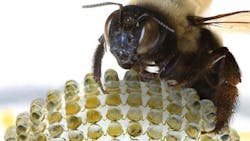Evanston, IL--An interdisciplinary team led by researchers at the University of Illinois at Urbana-Champaign and Northwestern University has developed a hemispherical digital camera inspired by the complex fly eye that contains 180 tiny microlenses for an exceptionally wide-angle field of view and sharp images. The new camera—a rounded half bubble similar to a bulging fly eye—can take pictures across nearly 180 degrees. The researchers say it would be simple enough to combine two of the hemispheres to get a 360-degree view.
Details of the biomimetic (http://www.laserfocusworld.com/articles/print/volume-48/issue-12/world-news/electronic-paper-displays-kindles-and-cuttlefish-biomimetics-informs-e-paper-displays.html) or bio-inspired camera, which required experts in optics, electronics, fabrication, and modeling and design theory, were published in the May 2 Nature paper entitled "Digital Cameras With Designs Inspired By the Arthropod Eye."
Northwestern's Yongang Huang, a senior author of the paper, said, "Each small eye, composed of a microlens and a microscale photodetector, is a separate imaging system, but when they are all taken together, the camera can take a clear picture, with just one snap, of nearly 180 degrees. The interface of different fields generates interesting new devices that never existed before." Huang is the Joseph Cummings professor of civil and environmental engineering and mechanical engineering at Northwestern's McCormick School of Engineering and Applied Science. Huang's lab was responsible for the modeling and design theory for the project, which took the whole team three years to complete.
The digital camera is the product of collaboration between Huang and John A. Rogers at the University of Illinois at Urbana-Champaign, who previously developed stretchable electronics and various devices using the technology, including an earlier digital camera, advanced surgical tools, and health/wellness monitors.
The 180 microlenses of Roger and Huang’s camera is comparable to the eye of fire ants and bark beetles, but less than the fly eye, which has thousands of small eyes. "A critical feature of our fly eye cameras is they incorporate integrated microlenses, photodetectors and electronics on hemispherically curved surfaces," said Jianliang Xiao, an assistant professor of mechanical engineering at University of Colorado Boulder and coauthor of the study. "To realize this outcome, we used soft, rubbery optics bonded to detectors/electronics in mesh layouts that can be stretched and deformed, reversibly and without damage." Xiao is a former doctoral student of Huang’s at Northwestern who then went on to work as a postdoctoral researcher in Rogers’ lab at Illinois.
The fabrication starts with electronics, detectors and lens arrays formed on flat surfaces using advanced techniques adapted from the semiconductor industry, Xiao said. The lens sheet—made from a polymer material similar to a contact lens—and the electronics/detectors are then aligned and bonded together. Pneumatic pressure deforms the resulting system into the desired hemispherical shape, in a process much like blowing up a balloon, but with precision engineering control.
According to the researchers, each microlens produces a small image of an object with a form dictated by the parameters of the lens and the viewing angle. An individual detector responds only if a portion of the image formed by the associated microlens overlaps the active area. The detectors stimulated in this way produce a sampled image of the object that can then be reconstructed using models of the optics.
SOURCE: Northwestern University; https://www.mccormick.northwestern.edu/news/articles/2013/05/bugs-eye-inspires-hemispherical-digital-camera-yonggang-huang-john-rogers.html

Gail Overton | Senior Editor (2004-2020)
Gail has more than 30 years of engineering, marketing, product management, and editorial experience in the photonics and optical communications industry. Before joining the staff at Laser Focus World in 2004, she held many product management and product marketing roles in the fiber-optics industry, most notably at Hughes (El Segundo, CA), GTE Labs (Waltham, MA), Corning (Corning, NY), Photon Kinetics (Beaverton, OR), and Newport Corporation (Irvine, CA). During her marketing career, Gail published articles in WDM Solutions and Sensors magazine and traveled internationally to conduct product and sales training. Gail received her BS degree in physics, with an emphasis in optics, from San Diego State University in San Diego, CA in May 1986.
